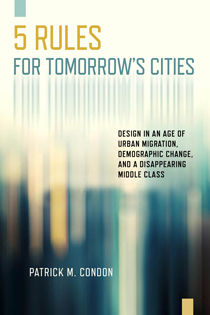"This book offers a contemporary grounding of the critical issues of our times in terms of built environment professionals and their roles in a global context....This is an excellent reading for studies in the built environment – key historical figures are referred to and recent global case studies serve to shore the relevance of their enduring legacy into focus once again."
Housing Studies
"The book’s exemplary organization, readability, and convincing message deserves more attention than most novels."
Manhattan Book Review
"Design professionals face a different and perplexing task: planning for a world with few babies, many old people, many impecunious young people, and a thin crust of the wealthy,...Condon’s refreshingly novel collection of examples for the future include Vienna, Mumbai, Sao Paulo, Vancouver, and Oregon. His discussion of Vienna’s century-long policy of taxing land to build housing is worth the price of the book in itself."
Planning
"In Five Rules for Tomorrow's Cities, Condon also provides grounded and financially feasible design examples for tomorrow's sustainable cities, and the design tools needed to achieve them."
Midwest Book Review
"In this succinct text, [Condon is] providing practical solutions to difficult questions. His experience as an urban planner and, subsequently, as an academic enable him to provide thoughtful, reflective insights on how cities must internally change over time, and how these shifts will impinge on residents as inevitable adjustments become necessary...His assessment offers an optimistic outlook for those areas that proactively endeavor to alleviate expensive financial and social costs of urban living in the future... ...Recommended."
Choice
"Condon writes persuasively and in considerable detail about his very reasonable five rules."
Urban Design Group
"This new book is power packed. It’s one of the most direct, informed, and pragmatic takes on the urban design of and for this century....This book should be on the desk of anyone who cares about the planet, especially media folk, academics, design professionals such as architects, engineers, urban designers, and planners."
Journal of the American Planning Association
"This is a masterpiece of urban thought, offering both an informed analysis of the challenges facing cities and a set of admirably clear and practical proposals for overcoming them. Patrick Condon has drawn on decades of hands-on urban experience to create a handbook that should be on the desk of every municipal leader."
Doug Saunders, columnist at the Globe and Mail, author of "Arrival Cities"
"This book's 'simple design rules for complex times' offer a much needed alternative to a profession obsessed with techno-green fixes and utopian whimsy. Condon translates 'systems thinking' into a practical urban design idea, that has the ability to scale up. He shows how changes brought by immigration, aging, and lack of affordability are not just footnotes to a design ideology, but essential design determinants. This concise, hopeful guide is an inspired fusion of big-picture thinking and practical design."
Emily Talen, Professor of Urbanism, University of Chicago, author of "Neighborhood"
"Hooray for Patrick Condon! In this eminently lucid and cogent book, he charts a sensible path through the daunting challenges that are now emerging for city-makers of all kinds. His recommendations in response are intelligent and remarkably practical. While his picture of the urban future is not pollyanna, neither is it despairing. We had better get with this program; as Condon points out, the next four decades will be pivotal for cities, and for us all."
Michael Mehaffy, Senior Researcher, Ax:son Johnson Foundation, author of "Cities Alive"

